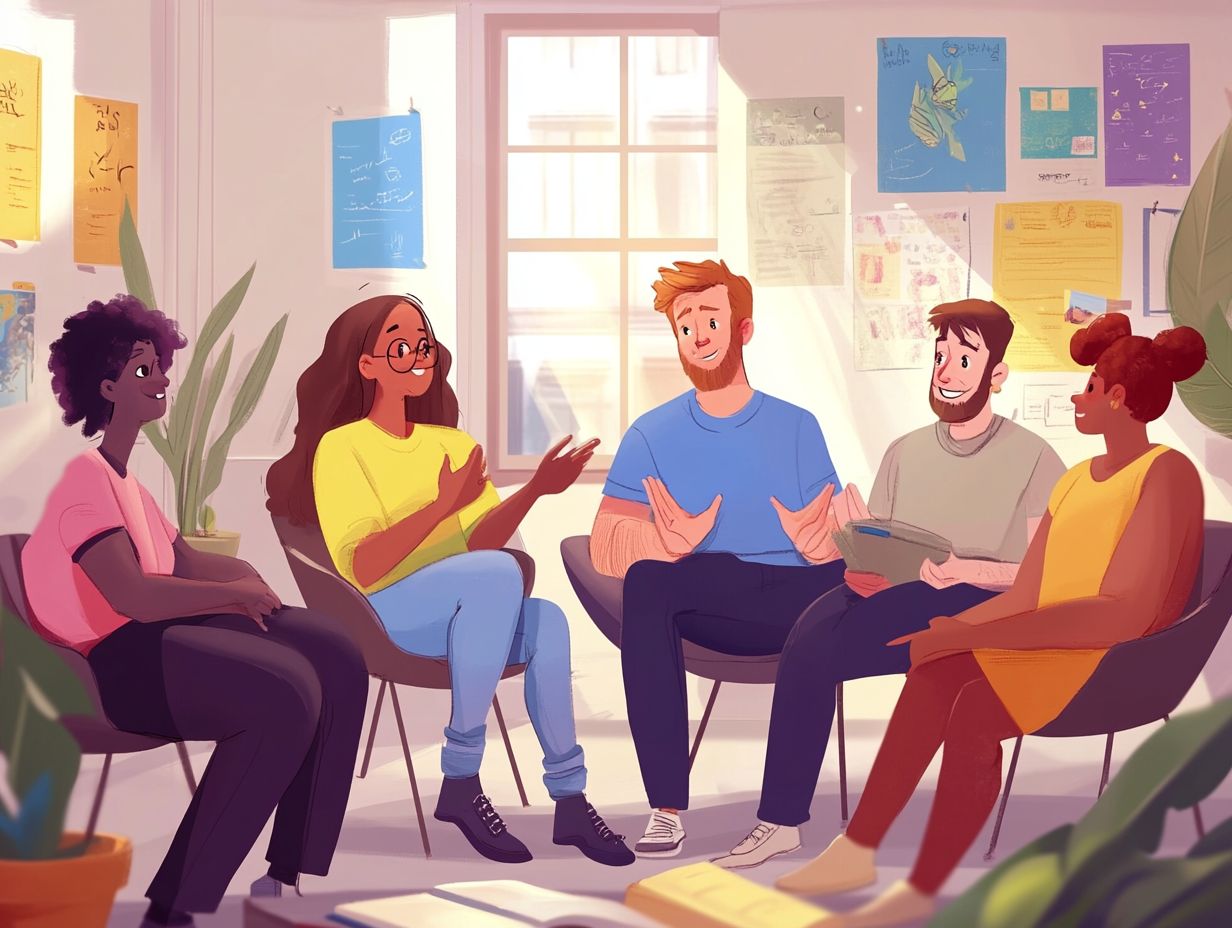5 Resources for Learning Sign Language
Learning sign language unlocks a remarkable world of communication and connection. It bridges the gap between hearing and deaf communities.
With a wealth of resources at your fingertips, from online courses to local classes, you’ll find something that suits your journey to enhance your skills. Discover five exciting methods to master sign language and enhance your communication skills!
This article discusses the importance of learning sign language and highlights the myriad benefits that accompany this valuable skill. It will also address common challenges you might encounter and offer practical tips for practicing and improving your proficiency.
Start learning to foster understanding and inclusivity through the beauty of sign language!
Contents
- Key Takeaways:
- 1. Online Courses
- 2. Mobile Apps
- 3. Community Classes
- 4. Books and DVDs
- 5. Join Local Sign Language Groups!
- Why Is Learning Sign Language Important?
- Frequently Asked Questions
- What are the top 5 resources for learning sign language?
- How can online courses help in learning sign language?
- Are books a good resource for learning sign language?
- What can DVDs offer for those interested in learning sign language?
- Can mobile apps be effective resources for learning sign language?
- Are local classes a good option for learning sign language?
Key Takeaways:

- Enjoy the freedom of learning at your own pace with online courses!
- Discover the fun of learning sign language on-the-go with mobile apps!
- Join community classes for a supportive environment and in-person practice!
1. Online Courses
Online courses have transformed how you can learn American Sign Language (ASL). They offer an abundance of free resources designed for every skill level, from beginner ASL to advanced courses.
Reputable providers like Emporia State University and Gallaudet University make it easy for you to connect with the deaf community. You can enhance your communication skills and gain a deeper understanding of deaf culture through interactive videos and customizable lessons.
Numerous online platforms such as Skillshare and American Sign Language University meet your diverse learning needs. They ensure you have access to essential ASL vocabulary and fingerspelling, which is the method of spelling out words using hand signs.
These resources incorporate technology-driven methods, including engaging online games that make learning enjoyable while reinforcing comprehension and retention effectively.
2. Mobile Apps
Mobile apps are invaluable tools for mastering American Sign Language (ASL). They provide engaging methods for you to practice fingerspelling, broaden your ASL vocabulary, and enhance your overall language comprehension.
These applications showcase interactive videos that allow you to see the signs in action. This ensures you grasp proper techniques while boosting your visual memory.
Many platforms provide customizable lessons tailored to your individual learning pace. Built-in ASL dictionaries act as handy reference materials, allowing you to quickly look up signs whenever needed.
The convenience of mobile technology means that your language instruction can occur anywhere, encouraging consistent practice. Apps like ASL App and TalkBoxMom utilize visual learning principles to keep you engaged, transforming your learning journey into an enjoyable experience.
3. Community Classes
Community classes present an exceptional opportunity to dive into learning American Sign Language (ASL) while connecting with local sign language groups and the vibrant deaf community. This experience fosters cultural awareness and enriches your communication skills.
You can select from a range of formats, whether you prefer intensive workshops focusing on specific skills or ongoing courses that provide a more thorough understanding over several weeks.
Engaging with fellow learners enhances your enjoyment and cultivates a sense of camaraderie essential for effective learning. These classes often feature interactive sessions that explore deaf culture, offering valuable insights into the rich traditions and experiences of its members.
This social aspect significantly boosts your ability to communicate effectively, making the transition from theory to practice both seamless and rewarding.
4. Books and DVDs

Books and DVDs dedicated to American Sign Language (ASL) are invaluable for your learning journey. They offer insights into the fundamentals of ASL, educational content, and effective techniques to deepen your understanding of this visual language.
These materials cover a broad spectrum of instructional resources, ranging from beginner-friendly guides that introduce essential vocabulary and grammar to advanced storytelling DVDs that delve into narratives expressed in ASL. Many of these resources seamlessly integrate with hands-on practice, interactive apps, and group sessions. This creates a comprehensive and enriching learning experience.
ASL interpreters are instrumental in helping you grasp complex concepts, showcasing the nuances of hand movements, facial expressions, and cultural contexts. Engaging with these diverse materials can significantly elevate your ASL skills, ensuring a captivating journey in learning this expressive language.
5. Join Local Sign Language Groups!
Joining local sign language groups lets you practice and boost your American Sign Language (ASL) skills. You’ll engage with the deaf community and participate in ASL clubs to share experiences and grow together.
These groups foster a supportive environment where you can connect with others who share your interest in ASL. Regular meetups often feature activities like storytelling sessions, game nights, and social events. These activities not only improve your signing proficiency but also foster friendships.
Participating in workshops and community events deepens your understanding of deaf culture. Complementing your formal ASL courses and online resources, these local gatherings present invaluable opportunities for real-world practice, making your language acquisition journey engaging and effective.
Why Is Learning Sign Language Important?
Learning American Sign Language (ASL) can transform how you connect with others! Mastering sign language is essential for effective communication and championing inclusivity within the deaf community.
When you dedicate yourself to learning ASL, you unlock the potential for authentic connections. This cultivates a more inclusive atmosphere in both your personal and professional life. The benefits of these skills go beyond the surface; communicating with deaf colleagues and friends fosters mutual respect and understanding.
ASL programs offer more than just a vocabulary of signs; they immerse you in the rich history and cultural significance of the deaf community. This deepens your comprehension and empathy. Educational experiences often include interactive workshops, storytelling sessions, and role-playing exercises. These opportunities reinforce your skills and underscore the importance of accessibility, ensuring everyone feels seen and heard.
What Are the Benefits of Learning Sign Language?
Learning sign language opens up a world of benefits, enhancing your communication skills and enabling effortless interaction with diverse groups. It deepens your cultural awareness of the deaf community and grants you access to a treasure trove of educational content tailored to various learning styles.
Understanding ASL can significantly elevate your cognitive abilities, sharpening your memory and problem-solving skills through its visual-gestural nature. This skill set promotes social integration, allowing you to engage more freely with the deaf community and unlock a wealth of professional opportunities in fields like education, healthcare, and social work.
Mastering ASL vocabulary enables effective communication in various contexts, whether in personal conversations or professional settings. To support your learning journey, consider utilizing resources such as online courses, community workshops, and interactive apps. These resources provide valuable guidance and practice, making the process both engaging and accessible.
What Are the Different Types of Sign Language?

Many types of sign language exist worldwide. American Sign Language (ASL) is one of the most well-known forms.
Each type reflects unique cultural values and communication styles. Fingerspelling plays an important role in them.
Unlike ASL, which originates from French sign language, British Sign Language (BSL) and Auslan have different grammar and vocabulary. This variety highlights the rich diversity in the deaf community.
Learning these languages helps you connect with others. It builds inclusivity and fosters deeper relationships across cultures.
How Can One Choose the Right Resource for Learning Sign Language?
Choosing the right resource for learning sign language is a careful choice that requires you to consider several factors. Think about your personal goals, preferred learning strategies, and the type of educational content that appeals to you be it engaging online ASL platforms or structured programs offered by community colleges.
As you evaluate different resources, take a critical look at the course structure, teaching methodologies, and student reviews. You might find that interactive mobile apps provide convenient practice on the go. Others may discover that community classes offer a richer experience filled with hands-on learning and social interaction.
It’s crucial to assess how each resource aligns with your learning style whether you flourish in self-paced environments or thrive on face-to-face instruction. By thoughtfully exploring these options, you can significantly enhance your journey in mastering sign language in a way that resonates with your unique preferences.
What Are Some Common Challenges When Learning Sign Language?
Many learners encounter familiar challenges when diving into American Sign Language (ASL). These challenges include mastering fingerspelling, honing their ASL skills, and adjusting to the intricacies of this visual language.
Fingerspelling, for example, can be particularly tricky. It demands not just dexterity, but also the speed and clarity necessary for effective communication. You might find the grammatical structure of ASL to be quite different from English, which can leave you feeling a bit bewildered.
Cultural nuances, like facial expressions and body language, play an important role in conveying meaning, adding another layer of complexity.
Dive into these challenges with confidence! Consistent practice is essential. Dedicating time each day to fingerspelling exercises or participating in community events can help cement these skills. Connecting with experienced signers or engaging with local deaf communities can offer invaluable insights and support, transforming the learning experience into something effective and truly enjoyable.
How Can One Practice and Improve Their Sign Language Skills?
Improving your sign language skills requires consistent practice through a variety of methods. You can dive into ASL apps, practice spelling with your fingers, participate in sign language games, and tap into social media platforms to connect with the deaf community.
Exploring ASL storytelling sessions offers invaluable insights into expressive signing. It also strengthens your cultural connections.
Interactive videos make it fun to see sign language in action, enhancing both your comprehension and retention.
Online games designed for ASL learners create a fun atmosphere to help you boost your skills through friendly competition. Community engagement is crucial for your learning; attending local deaf events or joining ASL clubs immerses you in an environment rich with practical application and shared experiences.
Explore various educational resources to make your learning journey effective. This approach encourages active participation and makes learning genuinely enjoyable.
Frequently Asked Questions

What are the top 5 resources for learning sign language?
The top 5 resources for learning sign language are online courses, books, DVDs, mobile apps, and local classes.
How can online courses help in learning sign language?
Online courses offer structured lessons and interactive exercises that can be accessed at any time, making it convenient for students to learn at their own pace.
Are books a good resource for learning sign language?
Yes, books provide a comprehensive guide to the basics of sign language, including grammar, vocabulary, and common phrases.
What can DVDs offer for those interested in learning sign language?
DVDs offer visual demonstrations of sign language, making it easier for learners to observe and imitate the correct hand gestures and facial expressions.
Can mobile apps be effective resources for learning sign language?
Yes, mobile apps provide a convenient way to access learning materials and practice sign language on the go.
Are local classes a good option for learning sign language?
Local classes provide the opportunity to learn from an experienced instructor and practice with other students, making it a great resource for hands-on learning and social interaction.
Start practicing today and unlock new ways of communication!





